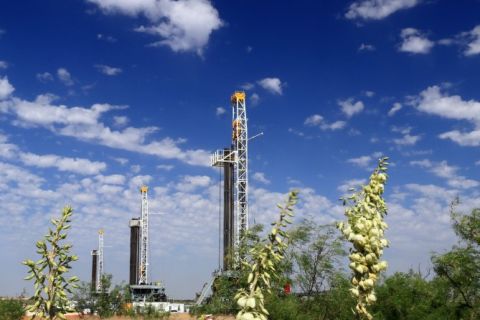U.S. crude oil output from seven major shale formations is expected to rise by about 80,000 barrels per day (bbl/d) in May to a record 8.46 million bpd, (MMbbl/d) the U.S. Energy Information Administration said in its monthly drilling productivity report on April 15.
The largest change is forecast in the Permian Basin, where output is expected to climb by 42,000 bbl/d to a fresh peak of about 4.14 MMbbl/d in May.
In the Bakken, shale production is estimated to rise by about 11,000 bbl/d to about 1.39 MMbbl/d, easing from a record 1.41 MMbbl/d hit in January. In the Eagle Ford region, output is expected to edge higher by 7,000 bbl/d to about 1.43 MMbbl/d, which would be the highest monthly output since January 2016.
Production growth in the Permian and other key shale basins have slowed as oil prices fell in the fourth quarter and many shale companies cut spending in the face of investor pressure to focus on earnings growth instead of increased output.
Prices have rebounded this year, but drillers are expected to remain cautious. Some shale producers are turning to workforce cuts as investors step up demands for returns.
However, major oil companies are boosting their presence, particularly in the Permian, the largest U.S. shale oil field.
The U.S. rig count, an early indicator of future output, remains higher than a year ago.
The EIA said producers drilled 1,388 wells and completed 1,392, the most since January 2015, in the biggest shale basins in March, leaving total drilled but uncompleted (DUC) wells down 4 at 8,500, according to data going back to December 2013.
That was the first decline in DUCs since March 2018. The DUCs hit a record high 8,504 in February.
Separately, U.S. natural gas output was projected to increase to a record 79.8 billion cubic feet per day (Bcf/d) in May, the EIA. That would be up 0.9 Bcf/d over the April forecast and mark the 16th consecutive monthly increase.
A year ago in May, output was 67.4 Bcf/d.
The EIA projected gas output would increase in all the big shale basins in May, except the Anadarko.
Output in the Appalachia region was set to rise almost 0.4 Bcf/d to a record 32.2 Bcf/d in May. Appalachia production was 27.1 Bcf/d in May a year ago.
Recommended Reading
Permian Activity in ‘Low-to-no-growth’ Mode for First Half
2024-02-22 - After multiple M&A moves in 2023 and continued E&P adherence to capital discipline, Permian Basin service company ProPetro sees the play holding steady.
EQT, Equitrans to Merge in $5.45B Deal, Continuing Industry Consolidation
2024-03-11 - The deal reunites Equitrans Midstream Corp. with EQT in an all-stock deal that pays a roughly 12% premium for the infrastructure company.
EQT Deal to ‘Vertically Integrate’ Equitrans Faces Steep Challenges
2024-03-11 - EQT Corp. plans to acquire Equitrans Midstream with $5.5 billion equity, but will assume debt of $7.6 billion or more in the process, while likely facing intense regulatory scrutiny.
Continental Resources Makes $1B in M&A Moves—But Where?
2024-02-26 - Continental Resources added acreage in Oklahoma’s Anadarko Basin, but precisely where else it bought and sold is a little more complicated.
Diversified Energy Buys NatGas Assets in Runup to LNG Exports
2024-03-19 - Diversified Energy will pay $386 million to buy 100% interest in Oaktree Capital Management’s assets in Oklahoma, East Texas and Louisiana.





